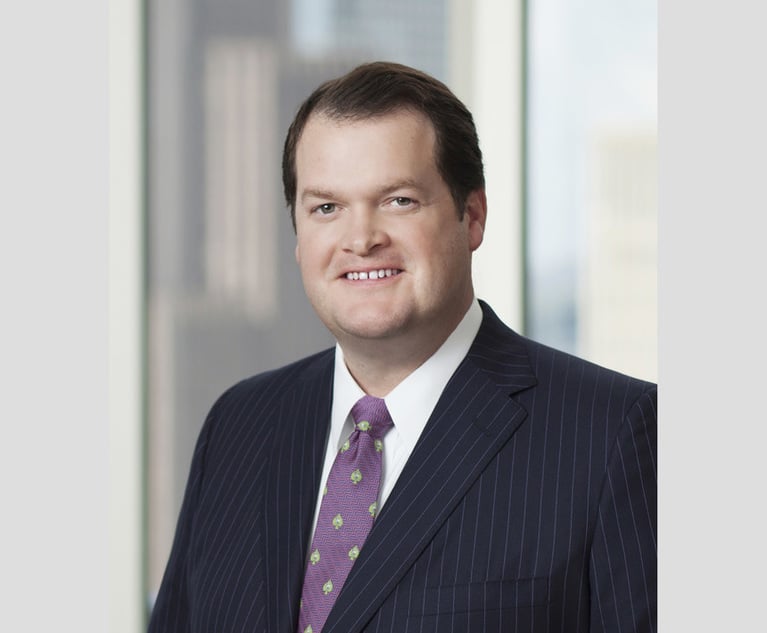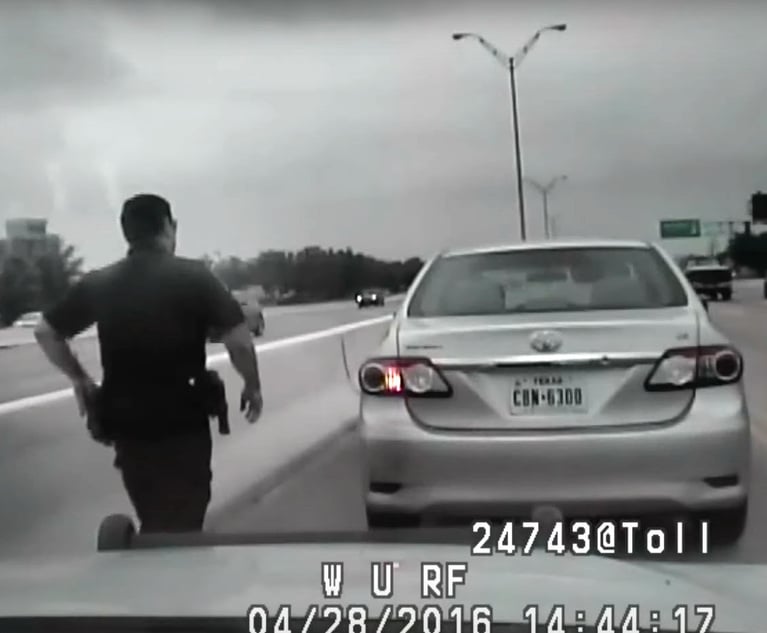Texas Supreme Court Gives Big Boost To Trial Lawyers' Use Of Video In Decision That Jeopardizes $10 Million Verdict
This story is reprinted with permission from FC&S Legal, the industry's only comprehensive digital resource designed for insurance coverage law…
March 05, 2018 at 11:16 AM
9 minute read

This story is reprinted with permission from FC&S Legal, the industry's only comprehensive digital resource designed for insurance coverage law professionals. Visit the website to subscribe.
The Texas Supreme Court, recognizing that video evidence “can be highly persuasive,” has decided that the Texas rules of evidence require that concerns such as unfair prejudice and the potential to mislead the jury must “substantially outweigh” the probative value of video evidence before a trial court may exclude it.
The Case
Diamond Offshore Services Limited and Diamond Offshore Services Company (together, “Diamond”) employed Willie David Williams as a senior mechanic on their offshore drilling rig. In January 2008, while working alone on a large, heavy piece of equipment, Mr. Williams hurt his back.
He never returned to work.
Despite two back surgeries in the 13 months following his injury, Mr. Williams continued to suffer back pain and related neurological issues with his foot and toes. Due to these issues and associated physical restrictions, his treating physician declared him “totally disabled at this point.”
In May 2011, Mr. Williams sued Diamond under the Jones Act, alleging that Diamond had been negligent and that the drilling rig was an unseaworthy vessel.
Shortly after filing suit, Mr. Williams underwent a functional capacity evaluation (“FCE”) to assess his physical abilities. The FCE detailed various physical restrictions and determined that Mr. Williams could perform medium-level physical labor within those restrictions.
As part of the FCE, Mr. Williams completed a pain questionnaire, and his responses were “consistent” with patients who were “exaggerating their symptoms.” The FCE thus concluded:
This score is not consistent with what the client was able to do during the FCE. The client's perception of [his] abilities is less than what he is capable of doing.
Based on this information, Diamond pursued a defensive theory that Mr. Williams was overstating his pain and downplaying his ability to return to some form of work. To support that theory, Diamond had Mr. Williams surveilled and recorded.
In December 2012 – 17 months after the FCE and nearly four years after Mr. Williams' second surgery – an investigator recorded him for about an hour over two consecutive days while he was engaged in limited physical activities.
On one day, the investigator videotaped Mr. Williams during a 27 minute time period, which included a break in recording of less than one minute. During that time, he operated a mini-excavator to clear away a run-down mobile home. He also bent over 34 times in a consecutive four-minute span to pick up smaller debris from the ground and throw it into a trailer bed.
The next day, the investigator filmed Mr. Williams working on his lifted truck over a 32 minute period, during which the investigator stopped and started recording several times, generating about 28 minutes of total video footage. Mr. Williams was perched on a stool for much of the time, but periodically stood up to gather tools and materials. At one point, Mr. Williams used his body to maneuver a large “monster wheel” onto his truck.
At trial nine months later, Mr. Williams testified that he still had “constant pain” in his back and was unable to hold any sort of job because of his pain, physical restrictions, and daily pain medication. His treating physician and other experts supported this assessment, disagreeing with the FCE's work-capacity conclusions and discounting it as outdated because Mr. Williams' condition had worsened in the intervening two years.
Mr. Williams explained that he would attempt to do activities he enjoyed, such as working on his vehicle and using the mini-excavator, but he could not engage in those activities for as long as he could before his injuries, and he hurt when he tried, both during and after.
Several of Mr. Williams' friends and family members described their observations of the mental and physical toll of his injury and pain and expressed concern that, based on their perception of his deterioration rate, Mr. Williams would be immobile or wheelchair-bound within a few years.
Diamond offered the surveillance video at trial to counter this evidence and corroborate the FCE.
Mr. Williams objected, contending that impeachment would be improper because Mr. Williams had admitted that he could engage in the activities portrayed, just not for an extended time period and not without pain. He also argued that the video was not “a fair representation of his disabilities or abilities” because “[i]t shows nothing of his life inside his home, the copious amounts of pain medication he must take to be able to perform these activities, or the price he has paid through the pain suffered in the subsequent hours and days” and thus should be excluded under Texas Rule of Evidence 403 as unfairly prejudicial and misleading.
The trial judge first considered admissibility at a motion in limine hearing and, after stating that she had not watched the video, ruled that Diamond could hold the video in its “reserve bank for impeachment, and that's it” and that if Mr. Williams “opens the door, then we'll take a look at it.” She did not otherwise state a basis for her ruling.
At trial, Diamond offered the video on three separate occasions, both for impeachment and as substantive evidence regarding Mr. Williams' pain and physical abilities. Each time, the trial judge stood by her prior ruling after only a brief exchange with counsel.
The jury returned a verdict for Mr. Williams, finding nearly $10 million in lost earning capacity, medical expenses, pain and suffering, disfigurement, and physical impairment.
In a split decision, the court of appeals affirmed, determining the trial court had not abused its discretion in excluding the video. The dissent would have reversed and remanded for a new trial, concluding that excluding the surveillance footage, which went “to the heart of each of [Mr.] Williams' damages questions,” had been harmful error.
The case reached the Texas Supreme Court.
The Texas Rules of Evidence
Texas Rules of Evidence 401 and 402 provide for the general admissibility of all evidence having any tendency to make a fact of consequence more or less probable.
Even if relevant, however, evidence may be excluded under Texas Rule of Evidence 403:
if its probative value is substantially outweighed by a danger of . . . unfair prejudice, confusing the issues, misleading the jury, undue delay, or needlessly presenting cumulative evidence.
The Texas Supreme Court's Decision
The court reversed.
In its decision, the court explained that although a trial court has “extensive discretion” in evidentiary rulings, its discretion was “not without limits.” Indeed, the court said, it afforded “no deference” when the record affirmatively established that the court could not have properly exercised its discretion – as in this case, it said, because “the trial court excluded the surveillance video despite never having viewed it.” Under these facts, the court ruled, that amounted to “an abuse of discretion.”
The court then held that, “as a general rule, a trial court should view video evidence before ruling on admissibility when the contents of the video are at issue.” Exceptions, the court added, should be “few and far between,” such as where the probative value of the evidence was so minimal that it would be obvious to the court that the potential prejudice substantially outweighed any probative value the evidence might have.
This case, the court found, did “not justify an exception.” In the court's opinion, proper exercise of discretion in this case required the trial judge to watch the video because Diamond sought to give the jury a visual representation of Mr. Williams “performing activities he said caused him pain.” The probative value of the evidence derived directly from Mr. Williams' appearance as he performed the surveilled tasks, and “[f]ully assessing the probative value of this visual was impossible based solely on the parties' descriptions.”
Finding no exigency that would have made viewing the video difficult, the court held that the trial court could not properly have exercised its discretion without watching the video.
The court then conducted its own independent Rule 403 analysis and concluded that any countervailing concerns did not “substantially outweigh” the video's probative value and, consequently, that the video could not be excluded under Rule 403.
The court rejected Mr. Williams' argument the video had been properly excluded as cumulative because he had admitted that he could do all the activities depicted, reasoning that videos were “qualitatively different than other types of evidence.” Allowing the jury to see what Mr. Williams looked like while engaging in the activities he was performing while being taped, “including how vigorously he worked, whether he limped or showed any difficulty in moving, how many times he bent over in quick succession, and whether he showed any signs of discomfort,” would have provided information that Mr. Williams' “bare testimony” could not.
The court concluded that because the video was “crucial to the defensive theories of exaggeration and dishonesty,” the video's exclusion probably caused the rendition of an improper judgment and, therefore, was harmful error.
The case is Diamond Offshore Services. v. Williams, No. 16-0434 (Tex. March 2, 2018). Attorneys involved include: For Diamond Offshore Services Company, Diamond Offshore Services Limited, Petitioners: Constance H. Pfeiffer, Lead Attorney, David M. Gunn, Kyle A. Lawrence, Beck Redden LLP, Houston TX. For Williams, Willie David, Respondent: Jeffrey L. Oldham, Lead Attorney, Bracewell LLP, Houston TX; Michael Patrick Doyle, Doyle LLP, Houston TX; Walter Z. Steinman, Law Offices of Walter Z. Steinman, Wyncote PA.
Steven A. Meyerowitz, Esq., is the Director of FC&S Legal, the Editor-in-Chief of the Insurance Coverage Law Report, and the Founder and President of Meyerowitz Communications Inc. As FC&S Legal Director, Mr. Meyerowitz, a member of the team that conceptualized FC&S Legal, provides daily analysis and commentary on the most significant insurance coverage law decisions from courts across the country and news regarding legislative and regulatory developments. A graduate of Harvard Law School, Mr. Meyerowitz was an attorney at a prominent Wall Street law firm before founding Meyerowitz Communications Inc., a law firm marketing communications consulting company.
This content has been archived. It is available through our partners, LexisNexis® and Bloomberg Law.
To view this content, please continue to their sites.
Not a Lexis Subscriber?
Subscribe Now
Not a Bloomberg Law Subscriber?
Subscribe Now
NOT FOR REPRINT
© 2025 ALM Global, LLC, All Rights Reserved. Request academic re-use from www.copyright.com. All other uses, submit a request to [email protected]. For more information visit Asset & Logo Licensing.
You Might Like
View All
Supreme Court Reinstates Corporate Disclosure Law Pending Challenge



Supreme Court Considers Reviving Lawsuit Over Fatal Traffic Stop Shooting
Trending Stories
Who Got The Work
J. Brugh Lower of Gibbons has entered an appearance for industrial equipment supplier Devco Corporation in a pending trademark infringement lawsuit. The suit, accusing the defendant of selling knock-off Graco products, was filed Dec. 18 in New Jersey District Court by Rivkin Radler on behalf of Graco Inc. and Graco Minnesota. The case, assigned to U.S. District Judge Zahid N. Quraishi, is 3:24-cv-11294, Graco Inc. et al v. Devco Corporation.
Who Got The Work
Rebecca Maller-Stein and Kent A. Yalowitz of Arnold & Porter Kaye Scholer have entered their appearances for Hanaco Venture Capital and its executives, Lior Prosor and David Frankel, in a pending securities lawsuit. The action, filed on Dec. 24 in New York Southern District Court by Zell, Aron & Co. on behalf of Goldeneye Advisors, accuses the defendants of negligently and fraudulently managing the plaintiff's $1 million investment. The case, assigned to U.S. District Judge Vernon S. Broderick, is 1:24-cv-09918, Goldeneye Advisors, LLC v. Hanaco Venture Capital, Ltd. et al.
Who Got The Work
Attorneys from A&O Shearman has stepped in as defense counsel for Toronto-Dominion Bank and other defendants in a pending securities class action. The suit, filed Dec. 11 in New York Southern District Court by Bleichmar Fonti & Auld, accuses the defendants of concealing the bank's 'pervasive' deficiencies in regards to its compliance with the Bank Secrecy Act and the quality of its anti-money laundering controls. The case, assigned to U.S. District Judge Arun Subramanian, is 1:24-cv-09445, Gonzalez v. The Toronto-Dominion Bank et al.
Who Got The Work
Crown Castle International, a Pennsylvania company providing shared communications infrastructure, has turned to Luke D. Wolf of Gordon Rees Scully Mansukhani to fend off a pending breach-of-contract lawsuit. The court action, filed Nov. 25 in Michigan Eastern District Court by Hooper Hathaway PC on behalf of The Town Residences LLC, accuses Crown Castle of failing to transfer approximately $30,000 in utility payments from T-Mobile in breach of a roof-top lease and assignment agreement. The case, assigned to U.S. District Judge Susan K. Declercq, is 2:24-cv-13131, The Town Residences LLC v. T-Mobile US, Inc. et al.
Who Got The Work
Wilfred P. Coronato and Daniel M. Schwartz of McCarter & English have stepped in as defense counsel to Electrolux Home Products Inc. in a pending product liability lawsuit. The court action, filed Nov. 26 in New York Eastern District Court by Poulos Lopiccolo PC and Nagel Rice LLP on behalf of David Stern, alleges that the defendant's refrigerators’ drawers and shelving repeatedly break and fall apart within months after purchase. The case, assigned to U.S. District Judge Joan M. Azrack, is 2:24-cv-08204, Stern v. Electrolux Home Products, Inc.
Featured Firms
Law Offices of Gary Martin Hays & Associates, P.C.
(470) 294-1674
Law Offices of Mark E. Salomone
(857) 444-6468
Smith & Hassler
(713) 739-1250






